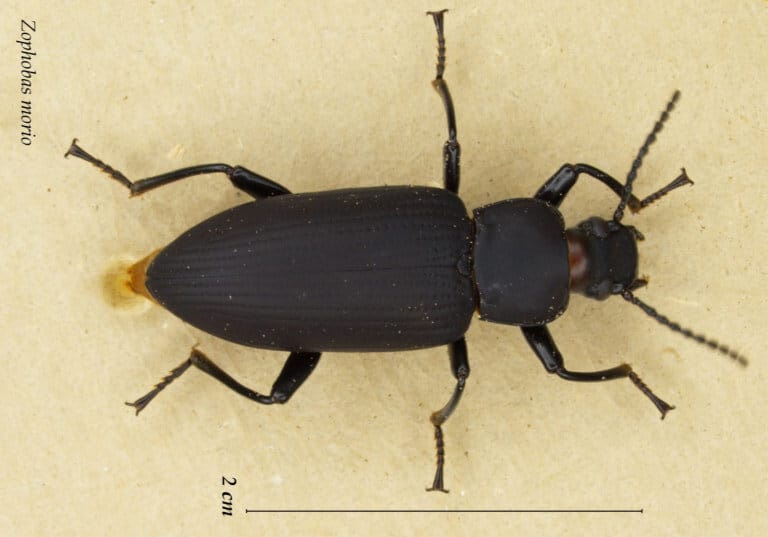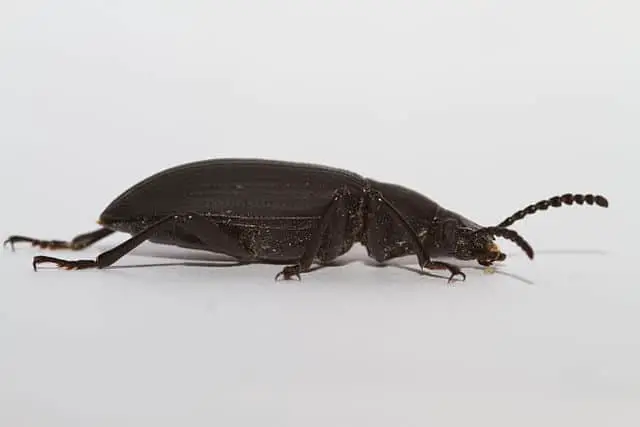Darkling Beetles (Zophobas morio) are popular in and out of the hobby, but not for their role as pets. Their larvae are often used to feed insect-eating pets such as reptiles and tarantulas. Chances are that you’ll recognize them as larvae and not beetles; however, they make ideal pets once they grow to be adults.
If you’re thinking about getting a Darkling Beetle for your collection, we’ve gathered all the information you need to know if they’re the best fit for you.

Darkling Beetle Care Sheet
| Name of species | Zophobas morio |
| Family | Tenebrionidae |
| Common name | Darkling Beetle |
| Category | Beetle |
| Type | Darkling beetles |
| Native location | Tropical Regions of Central America and South America |
| Size | 0.8-0.95 inches (2-2.4 cm) |
| Diet | Decaying organic materials such as other insects and animals |
| Lifespan | 8-10 Months |
| Experience level | Beginner |
Darkling Beetle Overview

The Zophobas Morio, just like most other members of its family, gets the name Darkling Beetle. It’s found in almost all tropical zones of Central America and South America, so it’s used to hot and damp environments.
It feeds on all sorts of decaying organic materials such as leaves and grass, but they prefer to eat fruit and vegetables.
Appearance
The Zophobas morio looks just the same as most other Darkling Beetles. Their larvae are very similar to mealworms, with the only difference being that they’re larger.
Like mealworms, the larvae of the Z. Morio are also light brown worms with horizontal segments and points of darker brown at both ends.
Fully grown, the beetles are black, small, and smooth. Their bodies are slightly flat, and they end in an arrowhead shape at their bottom end. In short, they’re very similar to most Darkling Beetles.
Price
Zophobas morio larvae are very easy to find and purchase since they’re used to feed other pets. You’ll find them at packages of 500 larvae for around $20 and 1,000 for around $35, so buying enough to start breeding and caring for them won’t be a problem for you.
As for adults, you’ll also find them in batches of 20 worms for around $35, which is also very accessible.
Behavior and Temperament
Darkling Beetles are a peaceful and communal species, so you won’t have issues handling and taking care of them. The beetles are unable to bite through human skin, and they won’t try to. Their only defense mechanism is to emit a foul odor when they feel threatened. This will keep most predators from preying on them, so that’s as far as they’ll go to defend themselves.
You don’t have to worry about them hurting you when you handle them, and, as long as you don’t have trouble with the smell, you’ll be happy handling these beetles.
Their capacity to live communally is something that you can also take advantage of. The larvae can be held together in small places with enough food and moisture. However, they won’t grow into adults unless you keep every larva separated; therefore, if you want your DBs to grow into adult beetles, you’ll need to give every larva a unique space for itself.
However, once the Darkling Beetles reach adulthood, you can keep them in the same enclosure and they’ll take care of breeding and surviving at peace.
Caring for a Darkling Beetle
Temperature and Humidity
The Zophobas Morio lives in tropical environments, so they’re comfortable in high temperatures. You should keep them at temperatures ranging from 70F° to 80F°.
As for humidity, they’re used to high humidity environments but made to survive with scarce sources of water; therefore, you shouldn’t worry too much about the humidity. However, if you want to make sure they’re safe, 50% to 70% humidity will be alright as long as they have good ventilation.
Substrate
Zophobas Morio larvae will feed on their substrate, so you should keep them in around two inches of oat flakes, wheat middlings, bran, or commercial substrates designed for this purpose.
Breeders that are only interested in them for their larvae will keep adults in the same substrate, but that’s not the best possible soil for them.
A mixture of coconut fiber and peat moss is actually the best option for these beetles if you want them to be comfortable.
Tank
Darkling Beetles don’t need too much space to live, but you should give them enough if you want them to be comfortable.
The enclosure should have at least three gallons of volume if you’re planning to house several specimens, and it must have good ventilation to avoid mold formation and diseases.
Decorative items such as fake plants and small rocks not only have visual value but also enable DBs to breed as they’ll lay their eggs in hard-to-reach places.
Watering
Darkling Beetles don’t need a particular water source since they get what they need from food. This means there’s no need to place a water dish inside the enclosure, and you could even risk them drowning if you do.
Instead, you can place a moist cotton wick or sponge in the enclosure if you want to make sure they get enough hydration.
As for the substrate, you don’t need to spray the larvae’s substrate with water as long as you place pieces of potato for their hydration. However, if you don’t bury some fruit, you’ll have to mist the substrate with water every day.
In either case, you’ll need to be mindful of mold formation, but this outcome is more likely when you’re spraying the substrate with water.
As for the adult beetle’s substrate, you should mist it with water every couple of days to keep it moist but not damp.
Feeding
Darkling Beetles are easy to feed. They’re not picky eaters in their natural habitats, so you won’t have trouble feeding them in captivity.
Just as we’ve mentioned earlier, the larvae can feed on their own substrate, so as long as you change the substrate regularly your DB larvae will be healthy and comfortable.
Adult Darkling Beetles need other types of food, but there’re plenty of options to choose from. Any types of fresh fruits and vegetables such as bananas, watermelon, melon, carrot, or potatoes are the best choice for them. They can also enjoy protein, so you could add fish food to their diet every once in a while and it’ll help them be healthier.
Fun Facts about the Darkling Beetle
- There are thousands of different beetle species that are Darkling Beetles, but the Zophobas Morio is one of the most popular ones as a pet. You’ll also see the Tenebrio Molitor in plenty of collections, but that one is more popular as a food source for other insects and arachnids.
- The larvae of DBs are a popular food source. In the case of the Tenebrio molitor, its larvae are the popular mealworm you’ll see at most pet shops. Now, speaking about the Zophobas morio, its larva is named morio worm or superworm because it’s larger than mealworms.
- Cultures and countries that practice entomophagy use superworms as food. They’re healthy to eat, easy to breed, and a great source of food with no foul taste, so there’s no reason not to add them to an insect-eating diet
Final words: Is a Darkling Beetle a Good Pet for You?
The Darkling Beetle is an amazing insect that should be part of any collection. It may not be as remarkable as other exotic insects such as the Japanese Rhinoceros or the Hercules beetle, but it’s simple, harmless, and useful.
- How Long Do American Eskimo Dogs Live? Important Factors and Care Tips - September 29, 2023
- Do American Bulldogs Need Grooming? Essential Tips and Care Guidelines - September 29, 2023
- Do Bengal Cats Enjoy Playing? Essential Tips for Keeping Them Active - September 29, 2023